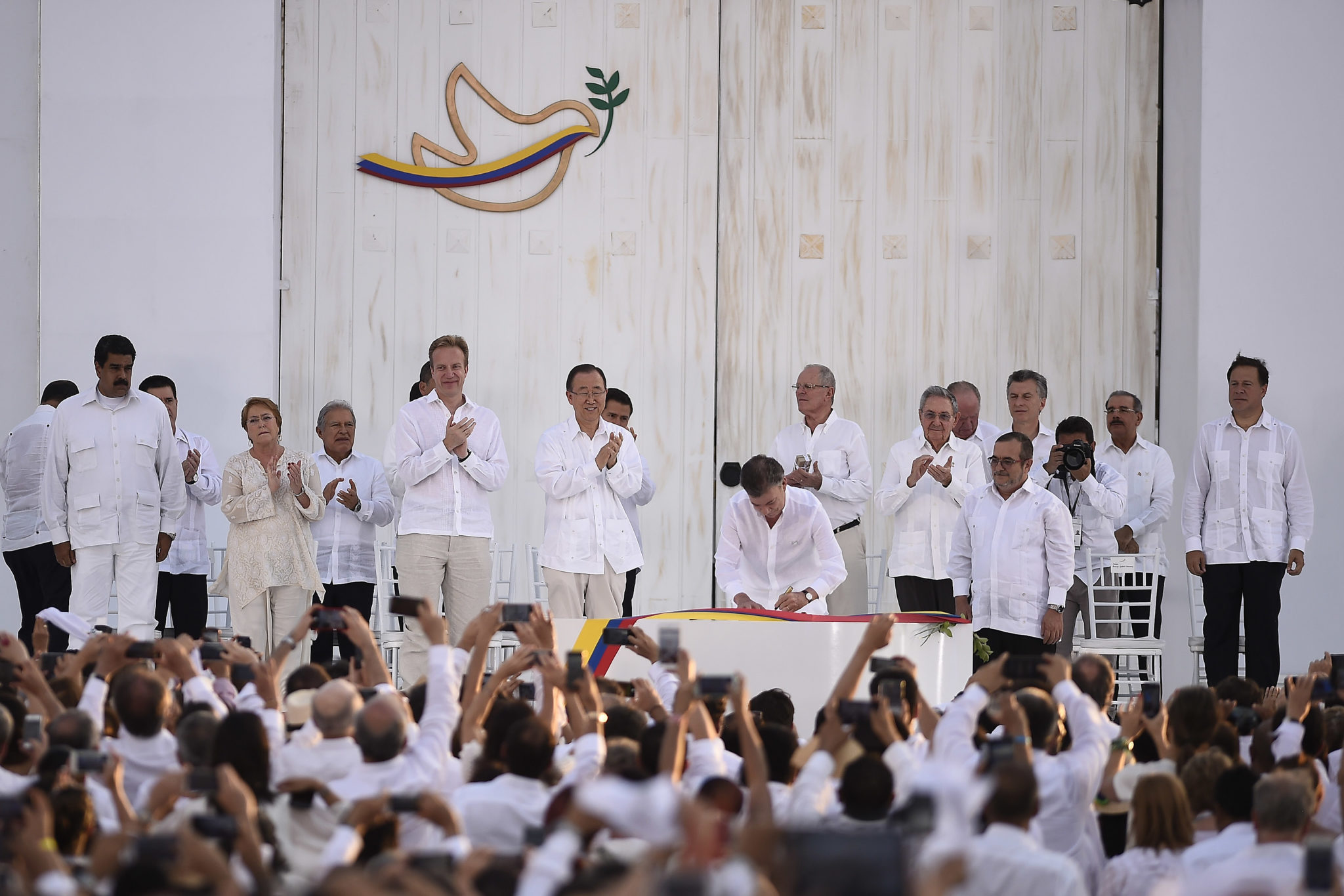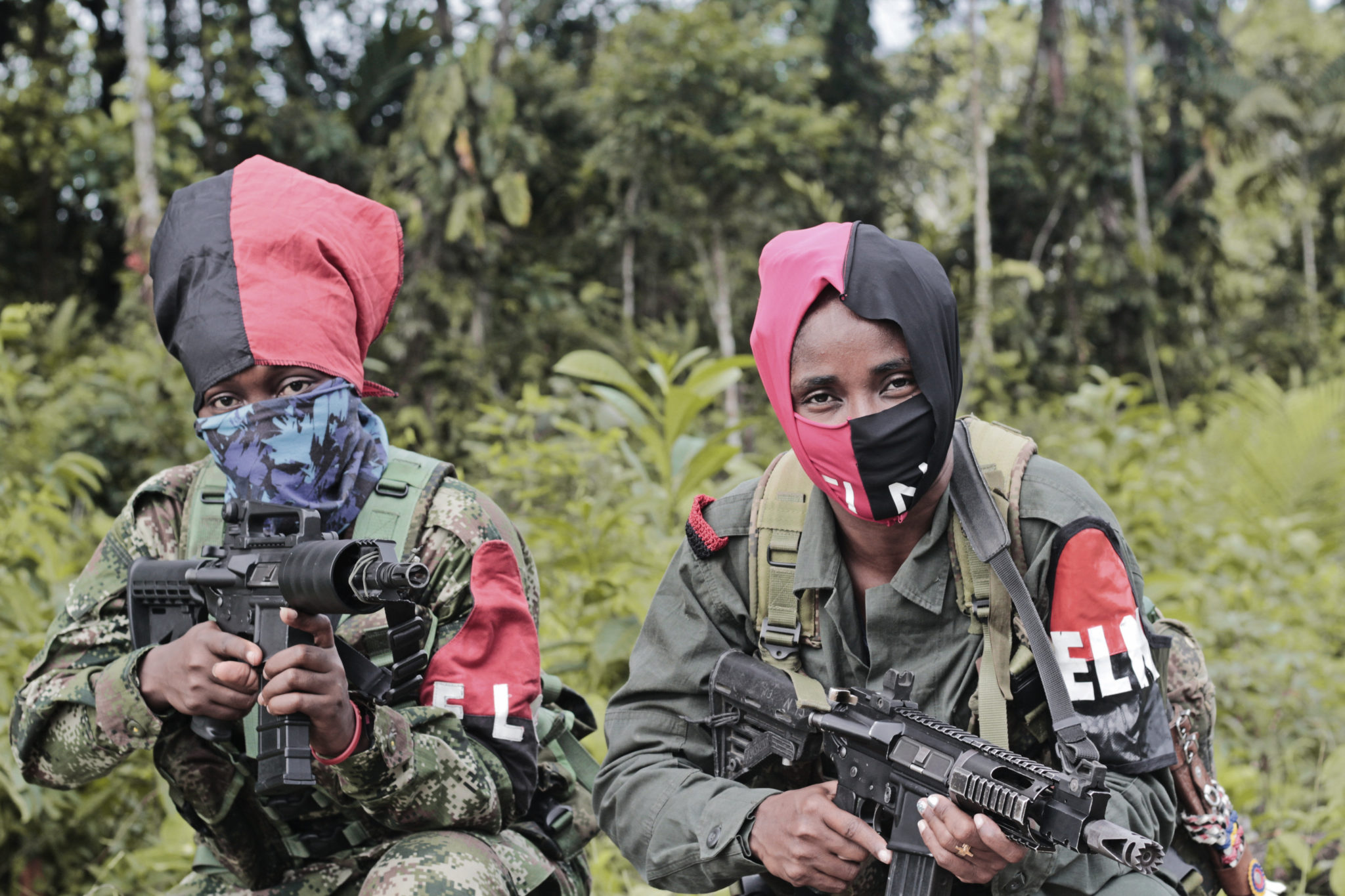
Colombian President Juan Manuel Santos signs the Peace Accords with the FARC in 2016.
“The law…empowers the president to initiate peace negotiations with groups such as the National Liberation Army (ELN), a faction of the Revolutionary Armed Forces of Colombia (FARC) who rejected a 2016 agreement and returned to the armed struggle, and another group that never signed the pact.”
Colombia’s new president, Gustavo Petro, came to power promising to negotiate a peace deal with the country’s notorious guerrilla groups and sundry criminal organizations. As with the 2016 Peace Accords, which ended the decades-long conflict with the Revolutionary Armed Forces of Colombia (FARC), Petro’s plan for what he calls “Total Peace” has become controversial. Broadly speaking, Petro plans to offer a blanket immunity in exchange for the demobilization of guerrilla groups, the disarming of criminal organizations, and the cessation of drug trafficking.[i] In the first excerpted article from CNN en Español, the Spanish-language affiliate of the popular U.S. outlet, the authors report that Colombia’s Congress approved enabling legislation permitting Petro to embark on peace negotiations with nearly all armed groups in the country. The article also notes that the legislation would set aside money to ensure development investment in demobilized areas. The second article, from Colombia’s generally left-leaning El Espectador, notes that rather than experiencing a decline, violence has instead surged under Petro, confounding the expectations of peace negotiations.
Petro’s plans for “Total Peace” will face increasing challenges as negotiations take off in earnest. First, the Colombian government’s dialogue with leaders of the Marxist National Liberation Army (ELN) is a gamble. It is unclear how much control the leadership, exiled in Cuba for years, still has over the guerrillas operating in Colombia’s borderland area with Venezuela. During previous negotiations with the FARC, the Colombian government quickly realized the autonomy that some FARC groups had from its central leadership structure, meaning an inability to impose the terms of agreement on individual groups. Second, the Colombian government may find it difficult to commit to concessions and simultaneously entice guerrilla groups to lay down their arms. During previous negotiations with the FARC, vacuums created by the demobilized guerrillas quickly were filled by other criminal groups, suggesting at least some Colombian criminal organizations will not commit to this latest peace process so they can take advantage of the lack of law enforcement pressure to increase territory and revenues from illicit economies.
Sources:
“Congreso de Colombia aprueba ley para negociar la paz con grupos armados como el ELN, facciones de las FARC y otros (Colombian Congress approves law to negotiate peace with armed groups such as the ELN, FARC factions and others),” CNN en Español (the Spanish-language affiliate of the popular U.S. outlet), 27 October 2022. https://cnnespanol.cnn.com/2022/10/27/congreso-colombia-aprueba-ley-negociar-paz-reuters-reux/
The law approved by the plenary session of the House of Representatives and previously by that of the Senate, empowers the president to initiate peace negotiations with groups such as the National Liberation Army (ELN), a faction of the Revolutionary Armed Forces of Colombia (FARC) who rejected a 2016 agreement and returned to the armed struggle, and another group that never signed the pact.
The legislation also authorizes the president to initiate dialogues with criminal gangs involved in drug trafficking and illegal mining such as the Clan del Golfo, whose leaders and members may receive benefits such as reduced sentences and non-extradition in exchange for the disclosure of routes to export cocaine and the delivery part of the fortunes obtained illegally.
“Violencia contra población civil: uno de los desafíos para alcanzar la Paz total (Violence against the civilian population: one of the challenges to achieve Total Peace),” El Espectador (Colombia’s oldest daily that generally leans left), 15 November 2022. https://www.elespectador.com/politica/violencia-contra-poblacion-civil-uno-de-los-principales-desafios-para-alcanzar-la-paz-total/
During the first 100 days of the current government, the highest peak of massacres of the year occurred. The number of victims of acts of massacre and forced displacement in the country also increased. The number of cases and victims of forced confinement…increased and was concentrated in three departments, specifically in territories inhabited by indigenous and Afro-Colombian populations.
Notes:
[i] For greater context into Petro’s campaign promise and the outlines of his negotiation strategy, see: Ryan C. Berg, “Colombia’s Leftist President Seeks to Resume Negotiations with National Liberation Army,” OE Watch, Issue 9, 2022. https://community.apan.org/wg/tradoc-g2/fmso/m/oe-watch-articles-2-singular-format/425694
Image Information:
Image: Colombian President Juan Manuel Santos signs the Peace Accords with the FARC in 2016.
Source: https://commons.wikimedia.org/wiki/File:Jefa_de_Estado_participa_en_ceremonia_de_la_Firma_de_la_Paz_entre_el_Gobierno_de_Colombia_y_las_FARC_E.P._(29953487045).jpg
Attribution: Wikimedia, CC-BY-2.0

